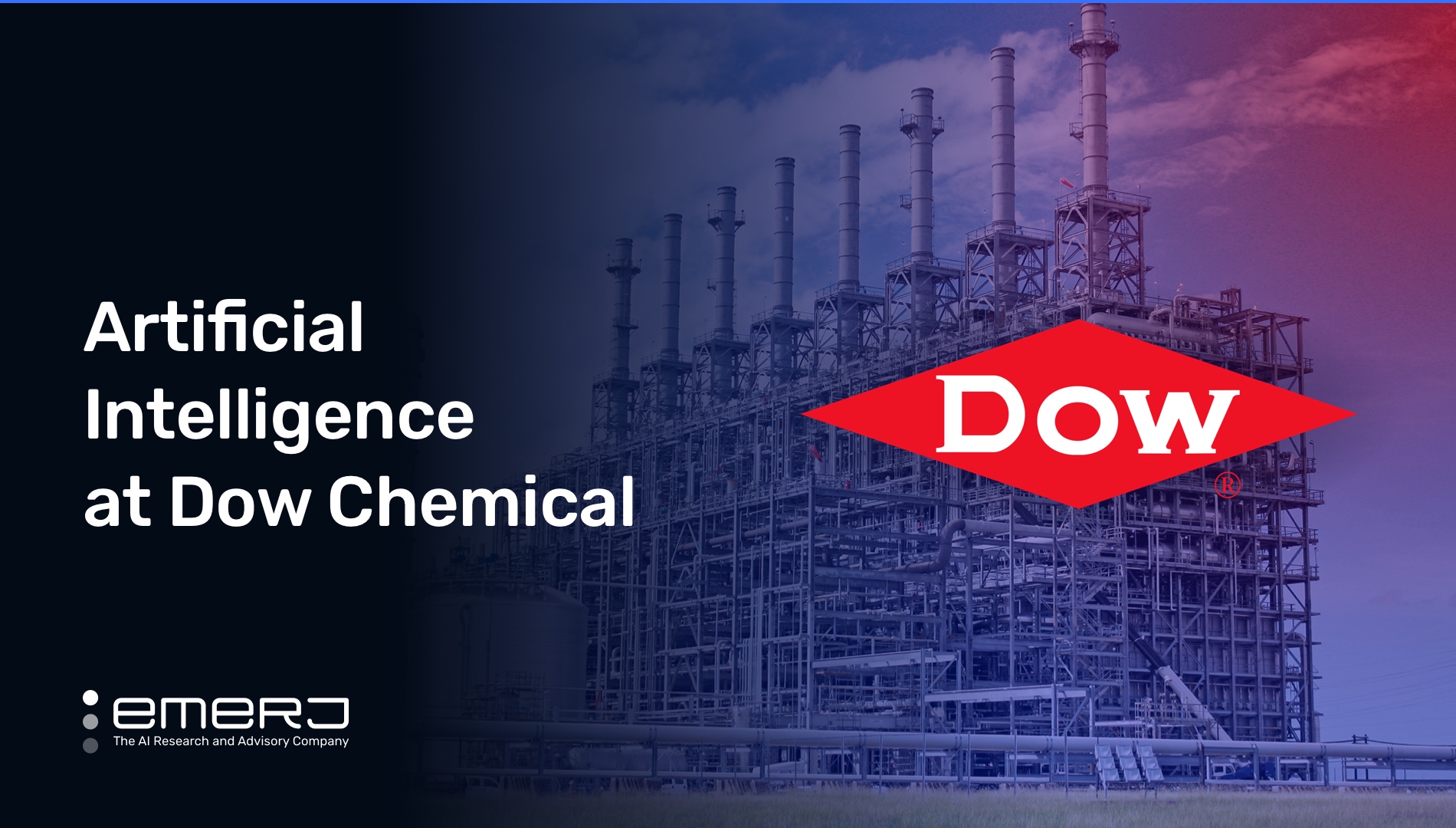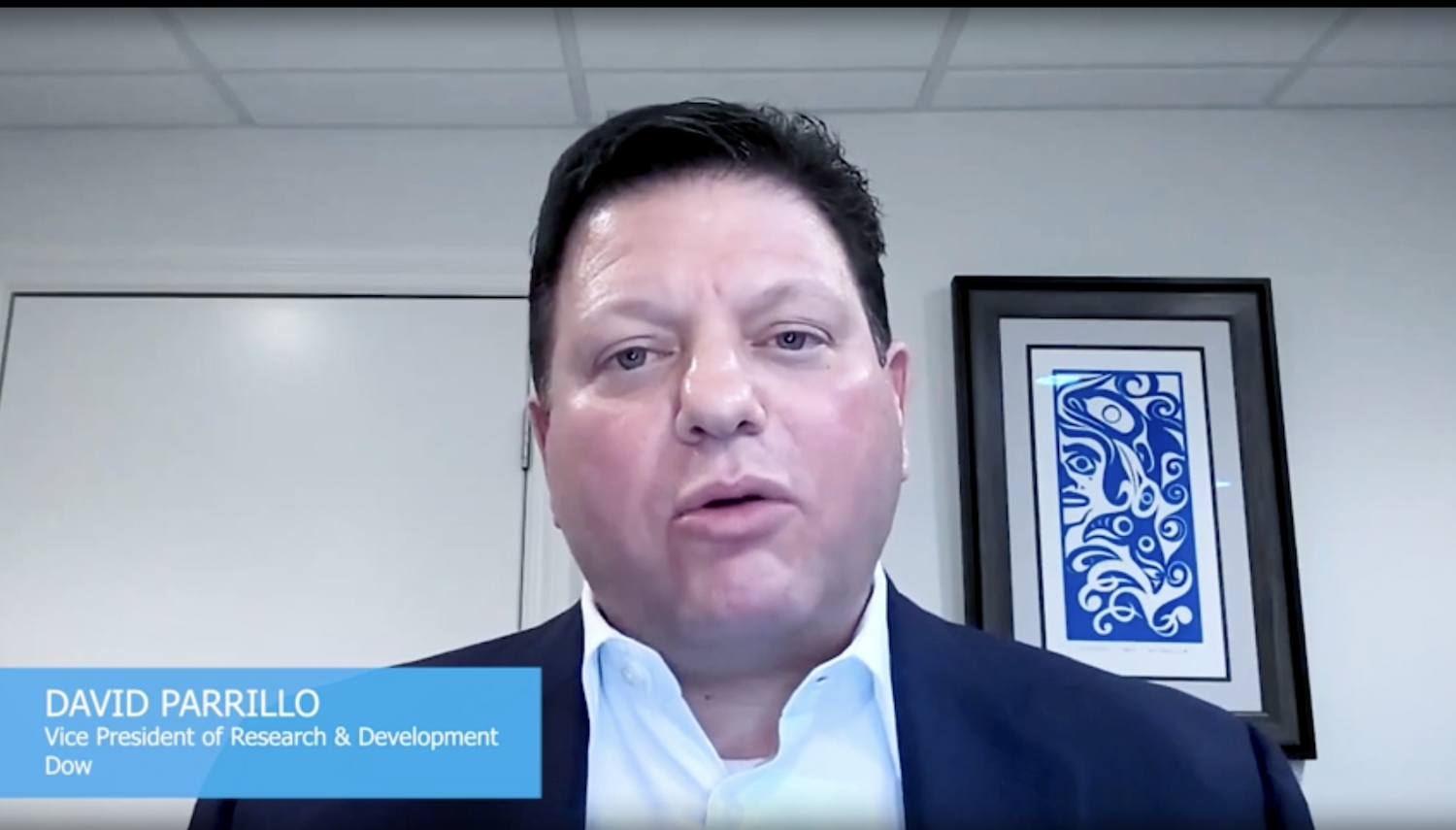Dow Chemical (NYSE symbol: DOW) is the largest chemical manufacturing company in the United States, the third largest in the world, and has a market cap of $38.2 billion.
In its 2021 annual report, Dow reported a net income of approximately $6.4 billion on $55 billion in net sales. As of December 31, 2021, the company employed 35,700 people globally.
Our research shows Dow has successfully deployed early AI projects with the help of household tech brands to solve meaningful business problems. Furthermore, these deployments lay the groundwork for a larger organization-wide transformation in the future, as signaled by recent marketing products and claims from Dow leadership.
This article examines two current use cases at Dow Chemical, in particular, that show how artificial intelligence initiatives currently support the company’s business goals:
- Automated, Predictive Polyurethane Fitting: Dow uses machine learning and predictive analytics to develop polyurethane products custom-fit to every individual customer.
- Detecting Containment Leaks: Dow Chemical uses computer vision and machine learning to detect containment leaks at its chemical plants.
We begin by taking a closer look at how Dow Chemical uses AI to develop custom-fit polyurethane products such as foams and semi-rigid plastics.
Use Case 1: Automated Polyurethane Fitting
Dow sought a solution to expedite the discovery process for developing new products such as foams and semi-rigid plastics for various industries (see list below.)
On its company website, Dow lists various polyurethane products produced at its plants. These products include:
- Polyurethane additives for a wide range of applications – footwear, mattresses, automotive interiors, and spray foam insulation
- Energy-efficient foam is used in cold storage solutions like appliances, insulated metal panels, and refrigerated transportation
- Anti-slip spray for transportation flooring solutions
- Binders for recycling applications
- Adhering and shredded materials like rubber
“No two customers buy the same product,” explains David Parrillo, Vice President of R&D at Dow, in a marketing video featured below forecasting the company’s AI initiatives in 2020. “That means we have to formulate and customize exactly for what each customer needs.”
(Source: Dow Chemical)
Before implementing the Microsoft solution, Dow purportedly used to consult multiple SMEs, with each expert requiring a consulting period of up to six months. Customer input, scientific investigation, and research are alleged to have all been done manually. Moreover, the older tools offered by the company to its scientists resulted in more incremental and challenging processes.
To accomplish its overarching business goal of expediting and automating polyurethane fittings, Dow partnered with the Microsoft Azure Machine Learning team. The idea was to produce an automated solution that could offer Dow’s scientists faster and more actionable.
According to Microsoft, training the model involved inputting “all of the team’s prior knowledge, expertise, and records about previous polyurethane formulations for customers.” The trained model used this data, ran the algorithm, and produced a customized product formulation for each customer. Unfortunately, the statement doesn’t provide much detail on what specific data was available to the end user from Dow’s research team. However, this data likely included polyurethane specimen data (e.g., stiffness level, compression/deflection PSI, etc.) and customer-related data (e.g., gender, age, purchase history, etc.)
Neither Microsoft nor Dow provides specific details on end-user interaction with the software. While we cannot determine from currently available public information precisely how the end user’s workflow changed, we can make some common sense suppositions.
Assuming that Microsoft’s prior statement concerning Dow’s lack of automation for polyurethane fitting is even remotely accurate, we may deduce that the workflow for its research scientists likely changed drastically. For example, Microsoft states that Dow’s new solution can sort through millions of possible fitting combinations and suggest areas for experimentation “in seconds.”
In its customer story about Dow, Microsoft claims that its solution “fundamentally transform[ed] a legacy process,” calling its solution for Dow part of a greater digital transformation.
Microsoft provided an illustration that, while possibly exaggerated, may shed some light on the changes made:
“For example, a customer might approach Dow looking for a polyurethane formulation to create a particularly soft mattress. Before machine learning, this would be the beginning of a long, manual process. Scientists would sit down at the laboratory bench and dig through textbooks and archived records of past work to guide their experimentation to find a new formulation.”
If the above statements from Microsoft are credible, we may assume that its solution supplanted at least some of the manual polyurethane fitting processes.
The customer story claims that Dow was able to drastically reduce the time necessary to research and develop custom-fit polyurethane products, reporting that what used to take scientists and other SMEs four to six months of work could instead be done “in a matter of seconds.”
Use Case 2: Detecting Containment Leaks
According to Microsoft’s customer story on the company, Dow Chemical had set the goal of zero safety-related incidents at its manufacturing plants. One of the incident types with which Dow is concerned is chemical leaks.
A Google search for leaks at Dow gives us insight into why this trepidation exists. Dow’s most recently publicized leak occurred in April of this year when a fire at a facility in Louisiana sprang a chlorine leak. Such safety incidents cost legacy industrial companies like Dow in both money and reputation.
Dow again partnered with Microsoft and its Azure team to accomplish this goal. In turn, Microsoft recommended implementing its Video Analyzer software as part of a comprehensive solution.
It is unclear what data Dow used to train its model. Most likely, the training data consisted of multiple labeled images of leaks – and of facilities with no leaks. It is clear that image classification was used, wherein the machine is:
- Provided with images and trained to recognize the relationships between said images and human-devised concepts, such as a leak hazard.
- Supplied input data from 24/7 camera feeds, which is then streamed through the Video Analyzer software algorithms for inference (see video below)
If the algorithm detects a leak, an edge device sends an alert to the customer via email, voice, or SMS call.
Below is a video of approximately two minutes in length that explains how Dow uses the software:
User capabilities include capturing, recording, and analyzing live video feed metadata. Users can publish or store the results in the Video Analyzer cloud service.
Similar to the first use case, we were unable to find specific, non-hyperbolic evidence of impact from either Microsoft or Dow Chemical. None of the reported benefits of the solution pertained to Dow’s purported zero-safety-incident objective.
Per a quote by a senior solutions manager at Dow, the company was able to assemble a scalable solution “to thousands of deployments.” Analytics and AI specialist at Dow, Mayur Andulkar, states that the decision to use Video Analyzer instead of custom development freed up the data team to focus on business logic and other tasks such as managing the detection and alerts.





















